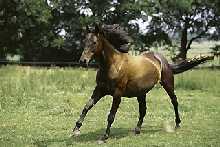| |
Reasons and risk factors for perioperative mortality in horses
 |
 Picture © Bayer Animal Health Picture © Bayer Animal Health
|
 |
Postoperative mortality in horses is a problem even after successful surgery: Self trauma when the horse tries to get up and cardio-respiratory problems are well-known reasons among horses practitioners and horse owners. A British prospective observational epidemiological multicentre study tried to find reasons and risk factors for death up to 7 days after anaesthesia.
|
 |
 |
|  |
Data were recorded from all equidae undergoing general anaesthesia in 62 clinics. Power calculations indicated that 45 000 cases were required to detect the significance of important variables. Details of each horse, operation, anaesthetic agents and clinic personnel were recorded. Outcome at 7 days was recorded as: alive, put to sleep (PTS) or dead. Data were analysed by a standard multilevel logistic regression approach, considering the effects of clustering at the level of clinic.
Data were collected from 41 824 cases over 6 years. A total of 39 025 (93.3%) were alive on day 7 and 785 were dead giving an overall death rate of 1.9% (95% CI: 1.8-2.0) and 2014 (4.8%) were PTS. About 5846 horses undergoing emergency abdominal surgeries (`colics`) were excluded from subsequent analyses. A total of 35 107 `noncolic` horses were alive at 7 days and 328 dead giving a death rate for noncolics of 0.9% (95% CI: 0.8-1.0). Five hundred and forty-three (1.5%) noncolic horses classified PTS were excluded from further analyses. There were 109 (33%) deaths from cardiac arrest or post-operative cardiovascular collapse, with 107 (32%) from fractures and myopathies. Fracture repair, out of hours surgery, and age below 1 month was associated with increased risk of dying whereas the use of acepromazine and intravenous anaesthetic agent maintenance of anaesthesia was associated with reduced risk.
A number of potential contributors to the high risk of anaesthetic-related mortality have been identified. Further investigation of the underlying mechanism for their apparent harmful effects and development of alternative techniques is merited.
Source: Johnston, GM, Eastment, JK, Wood, JLN & Taylor, PM (2002): The confidential enquiry into perioperative equine fatalities (CEPEF): mortality results of Phases 1 and 2. In: Veterinary Anaesthesia and Analgesia 29 (4), pp 159-170.
Tell a friend
|
Print version
|
Send this article
|
|  |

Limbal squamous cell carcinoma in a Rocky Mountain Horse and genetics Subconjunctival bupivacaine, lidocaine, and mepivacaine and the corneal sensitivity in horses Subconjunctival bupivacaine, lidocaine, and mepivacaine and the corneal sensitivity in horses Clodronate in horses with lameness Clodronate in horses with lameness Valacyclovir in horses with equine multinodular pulmonary fibrosis Valacyclovir in horses with equine multinodular pulmonary fibrosis Radiculopathy associated with forelimb lameness in horses Radiculopathy associated with forelimb lameness in horses Biological variations of routine blood parameters in horses Biological variations of routine blood parameters in horses Prognosis for horses with deep digital flexor tendon injury after penetrating wound Prognosis for horses with deep digital flexor tendon injury after penetrating wound Possible maternal effect for the pace trait of horses Possible maternal effect for the pace trait of horses Flecainide on induced atrial fibrillation in horses Flecainide on induced atrial fibrillation in horses Sonographic technique to identify manica flexoria tears in horses Sonographic technique to identify manica flexoria tears in horses Novel prototype dynamic laryngoplasty system on arytenoid abduction Novel prototype dynamic laryngoplasty system on arytenoid abduction Lipid peroxidation biomarkers in equine neuroaxonal dystrophy Lipid peroxidation biomarkers in equine neuroaxonal dystrophy
|















